UOW has been working to improve the environmental sustainability of its operations and has implemented initiatives and actions to reduce impacts and address UN Sustainable Development Goals.
Our progress
Environmental sustainability performance
UOW is a large consumer of energy. Energy efficiency in our operations and expanding the generation of onsite renewable energy as well as reducing fuel consumption is a focus as we work to reduce our Scope 1 and 2 carbon emissions. Understanding our Scope 3 carbon emissions and identifying ways to reduce them is also a priority. UOW has committed to achieving carbon neutrality by 2030 and is developing a roadmap towards achieving this commitment.
The management of energy and carbon on our campuses supports the implementation of the following UN Sustainable Development Goals:
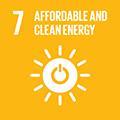
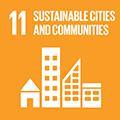
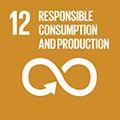
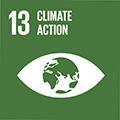
Policies, plans, standards and procedures
- Environmental Policy
- Carbon Management and Climate Adaptation and Resilience Action Plan (2022-2024) (PDF)
- Ecologically Sustainable Development (ESD) (PDF)
- Electrical Services Design Standards (PDF)
- Building Elements Design Standards (PDF)
- Mechanical Services Design Standards (PDF)
Data
Onsite renewable generation

- Total 1.6MW Solar PV installed at UOW campuses and facilities.
Total energy consumption

- 22% of energy is sourced from low carbon energy sources in 2022
Greenhouse gas emissions (scope 1 and 2 only)

- Scope 3 emissions have not been quantified as yet.
Initiatives
Scope 3 analysis and carbon neutrality roadmap
Scope 3 emissions are a large component of an organisation’s emissions profile. As such, scope 3 emissions must be quantified prior to developing a roadmap to achieving carbon neutrality.
In 2022 work commenced to establish the 2019 benchmark - Scope 3 emissions profile.
Energy efficiency projects
LED is the most energy efficient and cost effective lighting technology available. LED lights consume less energy than other technologies resulting in significant energy savings. Infrastructure and Property Division deployed a program of works to retrofit LED lights across Wollongong campus as well as in all areas undergoing refurbishment and all new buildings. Over 10,000 individual LED lights have been deployed and work is ongoing to review and retrofit more buildings at Wollongong campus as well as at other campuses and facilities. In 2024, the outdoor lighting at Wollongong campus was converted to LED.
Onsite renewable energy projects
Onsite solar photovoltaic systems have been installed at Wollongong and Innovation campus, and UOW facilities in Moss Vale which have been designed and installed to maximise consumption of the solar energy generated on site.
The Clean Energy Living Laboratory at Innovation campus is establishing a mixed use, precinct based microgrid at the Innovation campus to undertake critical research on infrastructure for microgrid-based electricity generation, storage, consumption, demand management and control technologies.
Microgrids and similar technologies will enable better management of energy generated onsite and further technologies and opportunities are currently being explored.
Renewable energy procurement
UOW is purchasing 100% renewable energy for its regional campuses via an agreement with Flowpower as well as purchasing green energy for some of its smaller facilities.
Electric vehicles and charging facilities
Shifting from internal combustion engine (ICE) vehicles to electric vehicles (EV) will assist in reducing fuel use and greenhouse gas emissions from UOW operations.
In 2024, UOW introduced two brand new electric buses for the UOW shuttle bus services. The previous service included electric hybrid buses that had been in use since 2016.
Electric vehicle charging is available at UOW. Innovation campus has had an electric vehicle charging station for many years that has been available for UOW fleet as well as public use. This charging station has been upgraded to a 180 kW Ingeteam charger during 2023 and work is now complete with the new charging station now operational.
At Wollongong Campus work will commence in 2024 to install three super-fast DC electric vehicle chargers that are being partial funded through the Drive Electric NSW EV Fast Charging Grants Program from the NSW Government Office of Energy and Climate Change.
Charging infrastructure is also being installed to support the transition of UOW fleet vehicles to electric at the Wollongong campus.
UOW operations include a range of activities that impact on water consumption and on water quality as a result sewer discharges and stormwater runoff. These include sports field maintenance, provision of food services, research, as well as general campus use. Growth in operations and climatic factors will continue to pose a challenge to reducing our drinking water resources.
Water consumed at all our campuses is either from the mains water supply or from rainwater that is captured and used onsite. Minimising potable water use, increasing rainwater capture and reuse and improving monitoring is a focus as UOW works towards being more self-sufficient in water management. Reducing impacts on water quality as well as the flow and volume of stormwater discharges is also a priority.
The management of water on our campuses supports the implementation of the following UN Sustainable Development Goals.
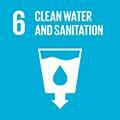


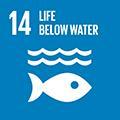
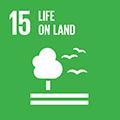
Policies, plans, standards and procedures
- Environmental Policy
- Water Management Action Plan (PDF)
- Ecologically Sustainable Development (ESD) Design Standards (PDF)
- Hydraulic Services Design Standards (PDF)
- Hazardous Waste Disposal Guidelines (PDF)
- Chemical management
- Emergency procedures guide
Data
Potable water use (mains water supply) consumed at our Campuses
UOW only uses mains water supply or captured rainwater at it's campuses. The data below represents the mains water supply consumption only. Data on the rainwater captured and reused is not currently available.

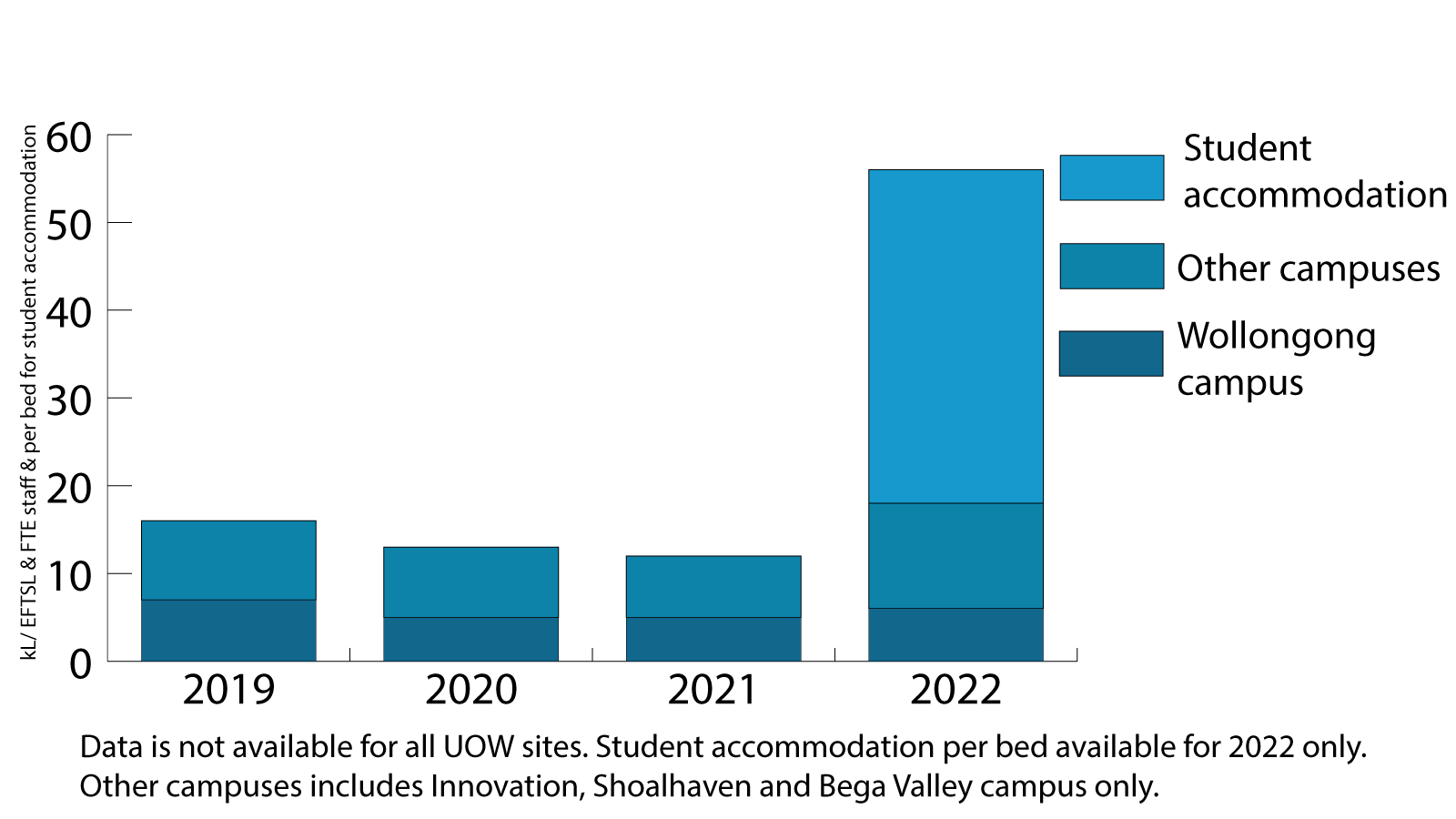
Initiatives
Water capture and reuse
3.2 Megalitres of rainwater storage is available across our campuses which is used for irrigation and toilet flushing helping to reduce our reliance on potable drinking water supply. Data on the amount of rainwater captured and reused is not available as this it is not currently metered at all rainwater tanks across our campuses.
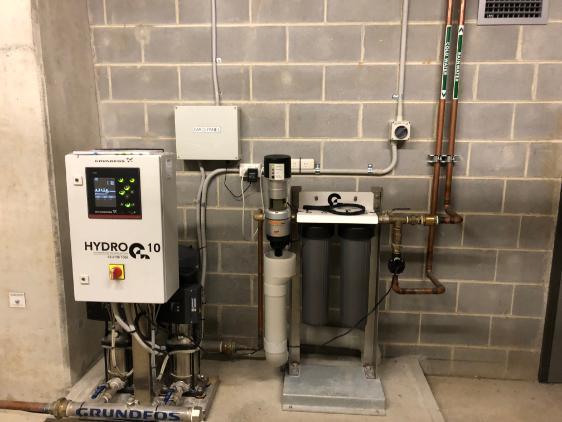
One example is at the Sustainable Building Research Centre (SBRC) on the Innovation campus which uses recycled rainwater except where local health and safety regulations require that potable water from public water supply must be used. Regular use of potable water in the SBRC is limited to the kitchen sink and dishwasher and a drinking fountain, and irregular use to safety appliances (with statutory requirements) such as a chemical safety shower and fire hydrants. All other water in the building is drawn from the 65,000 Litre underground rainwater tank. Both the rainwater and potable water usage is sub-metered and recorded in the building management system.
Wastewater management
All our campuses are located in sewered areas where wastewater discharged to the sewerage system is treated and managed by Sydney Water (or a similar local Government managed water treatment facility). However, as a requirement of the Living Building Challenge certification the Sustainable Building Research Centre (SBRC) on the Innovation campus has an onsite sewerage treatment system where wastewater is treated on site. The waste-water at the SBRC is treated through three stage process which is outlined (along with other sustainable design features of this building) on the Living Future Institutes website.
Across our campuses pre-treatment of wastewater is conducted prior to discharging to sewer and trade waste agreements are required with the water authority. There are approximately 11 grease arrestors and 19 dilution pits at Wollongong and Innovation campus and trade waste agreements are in place with Sydney Water.
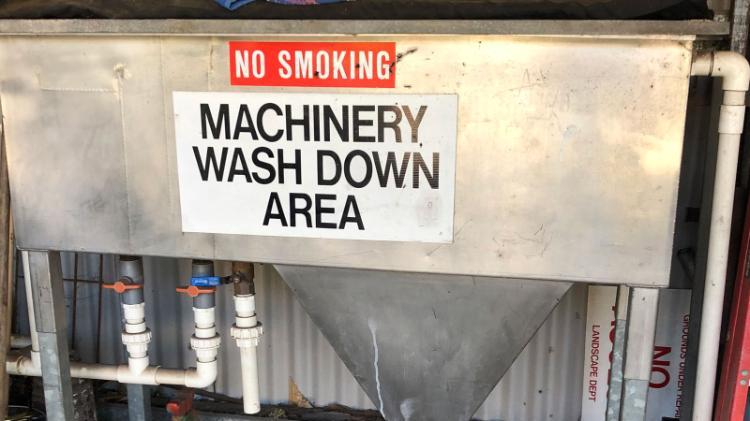
UOW also has an Envirowash system which is a water-based paint wastewater treatment system. It turns paint washed out from brushes and rollers into clean water and inert solid waste.
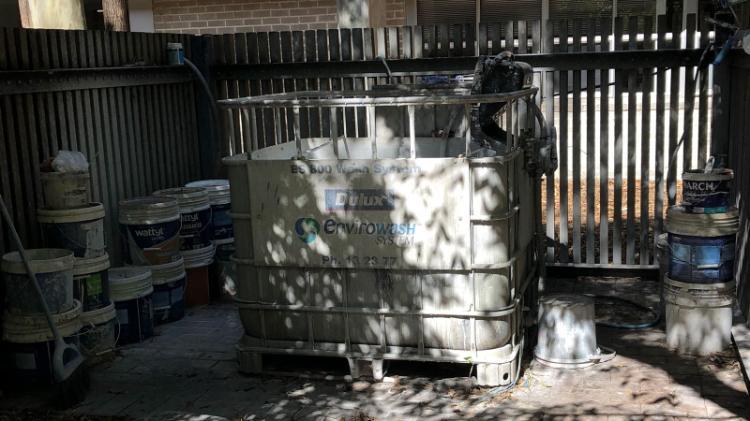
There are also several SPEL stormwater treatment devices at Wollongong campus that assist with detention and treatment of stormwater runoff.
Stormwater management and water sensitive urban design
On the Wollongong Campus at Building 42 is rain garden that is an example of water sensitive urban design principles being applied in new buildings. The garden around the building has been designed to filter stormwater runoff and slow the speed of water movement.
Landscape design principles for our campuses are to plant local native species that are better able to adapt and survive in local conditions. Aside from watering to establish new plants very little irrigation is conducted on our campuses as a result. Irrigation that is conducted is to maintain high quality sporting fields. Rainwater tanks and irrigation systems have been installed in these areas to enable management of efficient irrigation practices that utilise rainwater over potable water.
UOW is working towards achieving zero waste to landfill with the priority to avoid and reduce, reuse and recycle and (where there is no other feasible option) disposal and drive behaviours that create a circular economy in order to reduce the overall amount of waste generated. The management of waste on our campuses supports the implementation of the following UN Sustainable Development Goals:




Policies, plans, standards and procedures
- Environmental Policy
- UOW Procurement Policy
- Waste Action Plan 2022 - 2024(PDF)
- Hazardous waste guidelines and processes
Data
Waste disposal - Wollongong campus

 Data for other campus locations and accommodation sites is incomplete and currently unable to be reported. At some our campus locations waste and recycling data is not available due to the nature of the leasing and shared arrangements at those sites. UOW is continually working to improve the waste data it collects and expand the locations where data is able to be captured.
Data for other campus locations and accommodation sites is incomplete and currently unable to be reported. At some our campus locations waste and recycling data is not available due to the nature of the leasing and shared arrangements at those sites. UOW is continually working to improve the waste data it collects and expand the locations where data is able to be captured.
Initiatives
Avoiding waste
A number of initiatives have been implemented to reduce single use plastics and disposable packaging and to avoid waste being generated in the first place. These include the water bottle refill program with drinking water refill stations installed around the campus. The one less cup campaign is aimed a reducing disposable coffee cups with staff and students encouraged to use a reusable cup by either bringing their own, using a borrow a mug or dining in.
During 2021, UOW Pulse introduced a Sustainable Plate program in the Building 11 food court. Students, visitors and staff who are dining in are encouraged to use a reusable plate rather than single use packaging.
Diverting waste from landfill
Over the years a range of services and infrastructure have been provided to ensure that recyclable and food waste items are diverted from landfill at our campuses. These are continually reviewed and expanded and include:
- Increasing the availability of co-mingled recycling bins and food waste bins across our campuses in indoor and outdoor locations and improving the signage for bins in indoor and outdoor areas.
- Providing and promoting other recycling options (for items that can be recycled but not via the regular co-mingled recycle bins) including soft plastics, print cartridge, mobile phones, electronic waste, batteries and nespresso coffee pods.
- UOW has provided food waste bins in staff kitchens, student accommodation areas, and for events which is then collected by Soilco, a local food waste composting facility to be made into high quality compost materials. Food waste services are being explored for other campus locations however this is limited by availability of waste contractors in the campus areas that can collect food waste and divert from landfill.
- UOW Pulse has provided food waste collections for its tenanted and Pulse managed food retail outlets for food waste generated during food preparation. There are now also food waste bins in public areas such as the food courts and Unibar. UniBar has a Pulpmaster System to pulp food waste which is then collected and transported to Sydney to be turned into Biogas to produce electricity.
UOW is working to encourage sustainable transport to its campuses and reduce the carbon footprint associated with commuting and to improve the efficiencies and emissions associated with the fleet vehicles.
The management of transport and access initiatives on our campuses supports the implementation of the following UN Sustainable Development Goals:




Policy, plans and procedures
Data
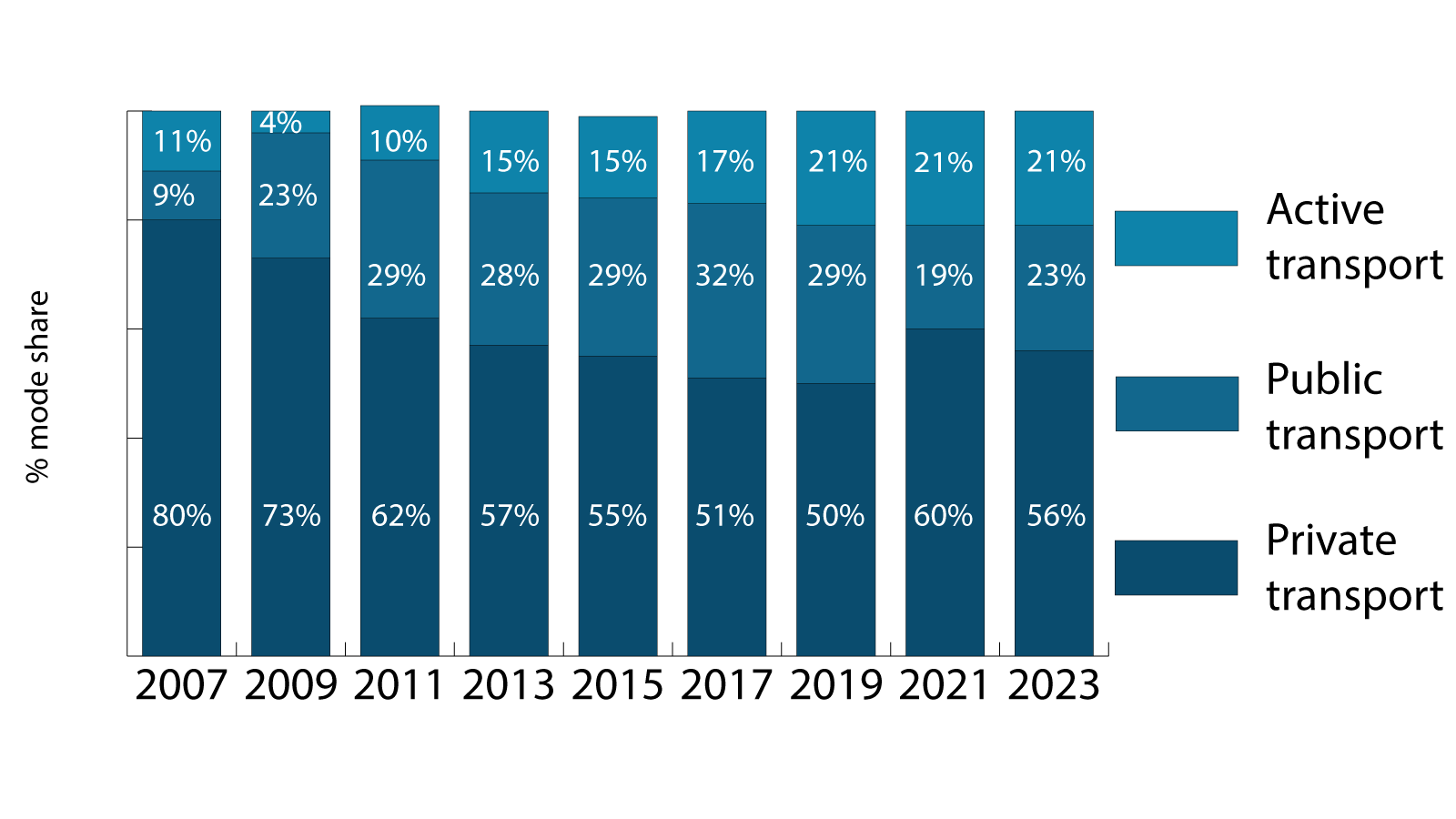
- A transport survey is conducted every two years to gather information on the movement of people and their mode of transport to the Wollongong campus for the survey week.
- In 2023, 56% of the campus population travelled by private vehicle, down 4% from 2021 and active transport usage has remained constant since 2019 at 21%.
- Travel behaviour during 2021 where private vehicle usage increased and public transport usage declined is likely due to the COVID-19 pandemic and changes to work and study arrangements.
Initiatives
Cycling facilities
A range of cycling facilities have been introduced to support cycling to our campuses.
Cycle paths and shared pathways
Cycle paths are managed by the Councils within the various local government areas. UOW works with the local Council to improve cycling access and wayfinding for cyclists to its campuses. In Wollongong the Wollongong City Council manage the cycle paths in and around Wollongong and Innovation campus and accommodation sites. Some are separated cycleways and others are on road bike paths.
All paths on the Wollongong and Innovation campus are shared pathways for cyclists and pedestrians. Wollongong campus is designed with an external ring road providing pedestrian and cyclist priority throughout the campus.
End of trip facilities
There are undercover and CCTV-monitored Bike Bases at Wollongong and Innovation campus where you can lock up your bike and have access to shower facilities, change rooms and toilets. They're free to use for staff and students. Lockers are also available in some bike bases.
Bike racks are located outside nearly every building. Bicycles must be parked at designated bike racks, and not chained to railings, light posts, trees or buildings.
Student accommodation also have bike storage facilities for use by residents.
Bike maintenance stands
Two bike maintenance and repair stations are available on the Wollongong Campus. Each station has tools for basic repair and an air pump. Video maintenance tips are available by scanning the QR code on the station. The stations are located at the Jugglers Lawn (near the Uni Bar) and outside Building 20, opposite Panizzi.
There is also a bike maintenance repair station at Innovation campus.
Electric bike charging facilities
Electric bikes are only to be charged in appropriate locations at university in accordance with manufacturer’s instructions and under direct supervision by the owner. Charging facilities are available at the Wollongong campus in building 29 and 43 bike bases.
Public transport
Paid bus services
Work to improve public transport services to our campuses is ongoing. Over the years UOW has liaised with Transport for NSW to improve bus services to various campuses. In 2020 these discussions lead to an additional bus service to the Shoalhaven campus to support students studying later in the afternoons. In previous years, discussions with Transport for NSW have also led to additional services being provided for the Campbelltown bus services to the Wollongong campus.
Shuttle bus services
Free shuttle bus services are provided by UOW for the Wollongong campus. UOW has funded a free shuttle bus service between North Wollongong train station and Wollongong campus since 2009 (prior to then it was a paid service).
The North Gong Shuttle bus services are are all low floor wheelchair accessible services.
There has been an electric hybrid bus used as part of the Shuttle bus fleet since 2018 helping to reduce fuel use and emissions.
UOW also partially funds the Gong Shuttle bus service that operates in a circular loop in a clockwise and anticlockwise direction and connects the Wollongong Campus with Fairy Meadow, Innovation campus and the Wollongong CBD.
Private transport
Accessible parking
Accessible parking is available at all our campuses.
Electric vehicles and charging facilities
Shifting from internal combustion engine (ICE) vehicles to electric vehicles (EV) will assist in reducing fuel use and greenhouse gas emissions.
Innovation campus has had an electric vehicle charging station for many years that has been available for UOW fleet as well as public use. This charging station has recently been upgraded to a 180 kW Ingeteam charger during 2023. This charger is now operational.
At Wollongong Campus work will commence in 2024 to install three super-fast DC electric vehicle chargers that are being partial funded through the Drive Electric NSW EV Fast Charging Grants Program from the NSW Government Office of Energy and Climate Change.
Infrastructure to support the transition of the UOW fleet vehicles to electricity also commenced in 2024.
UOW campuses are located in inner cities and regional locations. Wollongong, Innovation and Shoalhaven campuses contain biodiversity values. UOW is working to maintain and enhance the landscaped and natural bushland and riparian areas of our campuses, identify and monitor biodiversity values, manage habitats and reduce threats and improve awareness of these values with the campus community.
The management of biodiversity on our campuses supports the implementation of the following UN Sustainable Development Goals:





Policies, plans, standards and procedures
- Environmental Policy
- Wollongong Campus Biodiversity Action Plan 2020-2021 (PDF)
- Ecologically Sustainable Development (ESD) (PDF)
Data
- Over 50,000 native have been planted at Wollongong and Innovation Campuses since 1975.
- 162 native animal species are known to inhabit or visit the Wollongong campus.
- 9 native threatened animal species are known to inhabit or visit the Wollongong campus.
- 18 introduced animal species are known to inhabit or visit the Wollongong campus
- 500 native plant species are known on the Wollongong campus with 300 species native to the local Illawarra area.
Initiatives
Conservation, protection and management of biodiversity
- Identification of biodiversity values (flora and fauna species lists and vegetation communities) has been prepared for Wollongong campus Flora and Fauna of the Wollongong Campus(PDF)
- Bush regeneration activities at various locations within natural and riparian areas of the Wollongong campus.
- Managing and maintaining a database of trees .
- Monitoring the threatened species Cynanchum elegans that occurs on the escarpment lands of our Wollongong campus
- Management of asset protection zones to reduce the threat of bushfire at Wollongong, Innovation and Shoalhaven campus
- Installation of possum boxes and insect hotels
- Creation of the teaching and learning ponds to support on Wollongong campus research and teaching activities.
- Monitoring and maintenance of our ponds and wetland areas at both Wollongong and Innovation campus
- Preparation of a recommended planting list ensuring that local natives are prioritised in our plantings
Management of threats to biodiversity values
- UOW actively monitors for the presence of feral animals such as foxes, cats, rabbits and introduced ducks and deer and implements management actions as required. UOW is an active participant in the feral deer management program for the Illawarra. Feral deer are a major threat to the biodiversity of the region.
- UOW landscape team actively monitor the campus landscapes for the presence of environmental and declared weeds and is actively managing these on a daily basis.
- Managing habitat and tree values in the management of tree safety in landscaped areas and modify or delay work where possible to reduce impacts to fauna. Tree hollows are actively preserved in mature trees that require removal due to safety reasons by removing the unsafe parts of the tree and leaving the trunk with a natural or created hollow in place. Any tree pruning and removal activities that are required are properly assessed to ensure compliance with legislative responsibilities.
Awareness and knowledge of biodiversity
- Educational information prepared and available on our Campus environment website.
- Campus tours showcasing biodiversity and landscape are undertaken throughout the year to highlight the values of the campus biodiversity, understand the history of the campus landscape and gain a greater appreciation for the natural environments.
- Staff training to support biodiversity management (wildlife handling, conservation and land management, chemical safety).